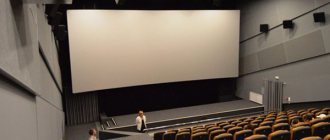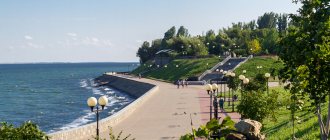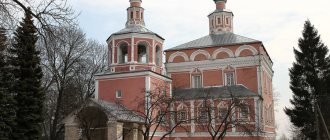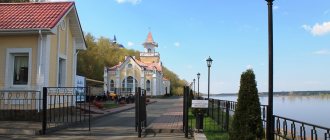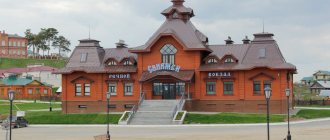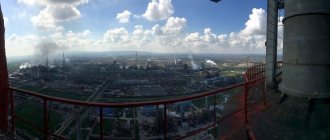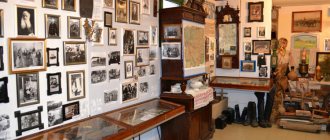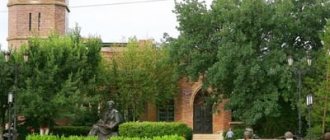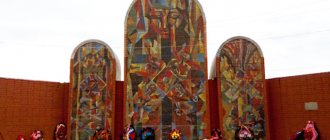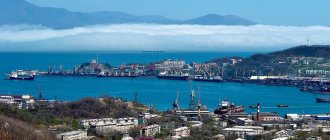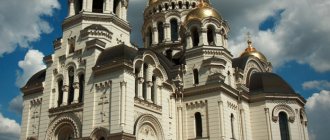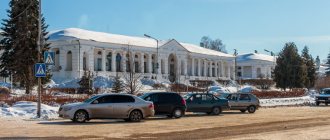City in Mordovia, Russia
| Ruzaevka Ruzaevka | |
| Town[1] | |
| Other transcription(s) | |
| • moksha | Orozay |
| Ruzaevka railway station, July 2013 | |
| Location Ruzaevka | |
| Ruzaevka Location Ruzaevka Show map of Russia Ruzaevka Ruzaevka (Republic of Mordovia) Show map of the Republic of Mordovia | |
| Coordinates: 54°04′N 44°56'E / 54.067°N Latitude 44.933°E / 54.067; 44.933Coordinates: 54°04′N 44°56'E / 54.067°N Latitude 44.933°E / 54.067; 44.933 | |
| A country | Russia |
| Federal subject | Mordovia[1] |
| Based | 1631 |
| City status from | 1937 |
| Height | 220 m (720 ft) |
| population (2010 Census)[2] | |
| • General | 47,523 |
| • Evaluate (2018)[3] | 45,248 (−4.8%) |
| Administrative status | |
| • Subordinate | city of republican significance Ruzaevki[1] |
| • Capital from | Ruzaevsky district[1], city of republican significance Ruzaevka[1] |
| Municipal status | |
| • Municipal district | Ruzaevsky municipal district[4] |
| • Urban village | Urban settlement Ruzaevka[4] |
| • Capital from | Ruzaevsky municipal district[4], urban-type settlement Ruzaevka[4] |
| Timezone | UTC + 3 (MSK [5]) |
| Postal code(s)[6] | 431440 |
| Dial code(s) | +7 83451 |
| OKTMO I WOULD | 89643101001 |
Ruzaevka
(Russian: Ruzáevka; Moksha: Orozai) is a town in the Republic of Mordovia, Russia, located on the Insar River, 25 km (16 mi) southwest of Saransk. Population: 47,523 (2010 Census);[2]49,790 (2002 Census);[7]51,034 (1989 Census).[8]
Story
The first settlement on the site of the city was given to Uraza Tankacheev in 1631 by the Russian Tsar Mikhail Fedorovich for faithful service. The owners of Ruzaevka were Tatar princes and Murzas (until 1715). For refusal to accept the Christian faith, these lands and serfs were bequeathed to the great emperor."
In 1725, the land and peasants were transferred to Lieutenant. Tikhon Lukin, who owned it for more than 30 years, then went bankrupt and in 1757 sold it to court advisor Jeremiah Struisky.
For more than a hundred years (1757-1861) Ruzaevka belonged to the wealthy feudal landowners Struisky. On the site where secondary school No. 9 is now located, there was a luxurious mansion. One of the pages of the history of Ruzaevka is connected with Nikolai Eremeevich Struisky.
Nikolai Eremeevich settled in Ruzaevka in 1771. Then he was 24 years old, he served for 8 years in the Preobrazhensky Regiment and retired with the rank of ensign of the guard. The estate bought by his father was located in the ground and was rich in underground water. Struisky invited the famous architect V.V. Rastrelli to design the building and church. Within six months, a three-story palace house was built. Nikolai Eremeevich lived there and wrote poetry, the third floor of his house was called “Parnas”. In 1783, he created a private printing house in Ruzaevka, which employed peasants who had studied printing at the Samara and Nizhny Novgorod printing houses. This printing house was one of the best for its time; the printing house printed mainly poems by Nikolai Eremeevich. These publications are extremely rare and have great bibliographic value. In 1905, it became one of the centers of the revolutionary movement that supported the uprising of Moscow workers. December 10 (23), 1905 under the leadership of a committee headed by a locomotive depot driver. Afanasy Petrovich Baykuzov went on strike, as a result of which electricity in the village and the nearest railway station passed into the hands of the workers. The “Ruzaevskaya Republic” was created, which existed for 12 days.
The Ruzaevka railway station is mentioned in the poems of the Latvian poet Alexander Čaks (Alexander Čaks - Latvian language) “Touched by Eternity” (“Mūžības skartie”). This poetry is about Latvian military riflemen. Return from the Russian Civil War in 1920.[9]
Steam locomotive-monument L-2345 “Lebedyanka”
As already mentioned, throughout the last century Ruzaevka was rightfully the center of the country’s railway economy. That is why you can easily spot steam locomotive monuments in the city. One of them, Lebedyanka, began its work in the year the Great Patriotic War ended, serving as the main transport in construction and restoration.
At that time, he was rightfully considered one of the fastest and reached a speed of almost one hundred kilometers per hour. About four thousand of the same locomotives were produced, and initially they were simply called by the first letter - L. The locomotive was already popularly named Lebedyanka.
Location: Station Square - 5.
Administrative and municipal status
Within the structure of administrative units, Ruzaevka serves as the administrative center of Ruzaevsky District, even though it is not part of it.[1] As an administrative division, it is registered separately as the city of republican significance of Ruzaevka
- an administrative unit with a status equal to that of a district.[1]
As a municipal entity, the city of republican significance of Ruzaevka is part of the Ruzaevsky municipal district as the Urban Settlement of Ruzaevka
.[4]
Steam locomotive-monument M-202 “Cuckoo”
You will find the second locomotive monument on the territory of the local depot museum, which will be discussed below. “Cuckoo” is an example of a very old model of a steam locomotive, which began to be used at the dawn of the eighteenth century in the mines of Altai.
Subsequently, the scope of their activity expanded, and they actively served in agricultural work, at the front, and in construction. Unfortunately, by the turn of the twentieth and twenty-first centuries, narrow gauge steam locomotives were no longer in demand, and they were discontinued. The monument was erected in the summer of 1970; the locomotive itself worked at the depot for about forty years.
Infrastructure
There are several museums in Ruzaevka:
- Museum of Local Lore [1]
- Railway Museum [2]
- Branch of the Mordovian Art Museum [3]
There are 8 libraries, the Orion recreation center, the Iskra cinema, the Neptune swimming pool and the Dolphin swimming pool. But the oldest and most famous club in Ruzaevka is the Ukhtomsky club.
In 1952, residents of the city of Ruzaevka received a big gift - a railway club, a magnificent building in the Stalinist Empire style, which has no analogues in the republic to this day. The club was named in honor of Alexey Vladimirovich Ukhtomsky, a railway worker who accomplished a legendary feat - in 1905 he saved a train with soldiers from the fire of executioners. The club opened its doors to all residents of the city. All generations of citizens participated in various clubs and societies. The heyday of urban culture began in the distant 1960s, when Igor Aleksandrovich Peresleny, Nikolai Kiselev and many talented creative leaders worked at the club.
The club was and remains a favorite place for the townspeople. Before you could watch movies, there was a national university here with five faculties of pedagogical and legal knowledge, culture, and health. The club's library had 2,500 readers. He is known for his dramatic circle, which produced nationally known national artists. The club brass band and folk instrument orchestra were very popular. The following were organized: a Russian song choir, dance clubs, an art workshop and many clubs. From the first days of its existence, the Club became a symbol of the city.
We are proud of people who are famous not only in our city and republic, but also beyond its borders. Artist of the Russian Federation and the Republic of Mordovia, laureate of the State Prize of the Russian Federation. Republic of Mordovia, Honorary Citizen of Ruzaevka Alexandra Nikolaevna Kulikova; artist of the Republic of Mordovia, laureate of the State Prize of the Republic of Mordovia, honorary citizen of Ruzaevka Lyubov Denisova; Honored Artist of the Republic of Mordovia Vladimir Ivanovich Sidorin, Honored Cultural Worker of Mordovia Anatoly Batenkov.
In the 1970s, no less talented people worked. Honored cultural figures of Mordovia Galina Stepanovna Sukhanova, Alexander Ryabov and Anatoly Beniaminovich Markaryan took their first creative steps.
Sights of Ruzaevka
Despite the fact that the town occupies a relatively small area geographically, there is also something to see here. Below are just some of the interesting places in Ruzaevka:
- Holy Trinity Cathedral. This temple was erected in 2009 and consecrated in 2012. One of the youngest cathedrals not only in Mordovia, but throughout Russia. The brick building is made in a very elegant and harmonious style. This is a real decoration of the city.
- Monument "Black Tulip". The monument is dedicated to the memory of the victims of the wars in Afghanistan and Chechnya, built thanks to the voluntary efforts of the entire caring population of Ruzaevka. It consists of three columns on which a bell is located, and at the bottom center of the base of the columns there is a bowl of a black tulip, symbolizing the plane on which the soldiers made their last flight.
- Paygarm Paraskeva-Voznesensky Convent. The monastery was founded in the mid-19th century, on the initiative of local residents. The building was then used for completely different purposes. So, during the revolution there was a military headquarters and a hospital here, after which the monastery became a state farm, then a hospital. Already at the end of the last century, the monastery was returned to Orthodox believers and clergy.
- Steam locomotive-monument L-2345 “Lebedyanka”. Steam locomotives-monuments for the city, which was a major railway center, are a common occurrence. Lebedyanka actively participated in the restoration and construction of the city in the post-war years. Its maximum speed reached about 100 km/h. This is one of the fastest locomotives of that time.
Recommendations
Notes
- ^ a b c d f g gram
Law No. 7-Z - ^ a b
Federal State Statistics Service of Russia (2011).
“All-Russian Population Census 2010. Volume 1" [All-Russian Population Census 2010, vol. 1]. All-Russian Population Census 2010 [All-Russian Population Census 2010]
(in Russian). Federal State Statistics Service. - "26. The size of the permanent population of the Russian Federation by municipalities as of January 1, 2022.” Federal State Statistics Service. Retrieved January 23, 2022.
- ^ a b c d f
Law No. 14-Z - "On the calculation of time." Official Internet portal of legal information
(in Russian). June 3, 2011. Retrieved January 19, 2022. - Post office. Information and computing center of OASU RPO. ( Post office
).
Search for postal facilities ( Search for postal facilities
) (in Russian) - Federal State Statistics Service of Russia (May 21, 2004). “The population of Russia, the constituent entities of the Russian Federation as part of federal districts, urban settlements, urban settlements, settlements, settlements is 3 thousand or more people” [Population of Russia, its federal districts, constituent entities of the federation, districts, urban settlements, rural settlements - administrative centers, rural settlements with a population of more than 3000 people] (XLS). All-Russian Population Census of 2002 [All-Russian Population Census of 2002]
(in Russian). - “All-Union Population Census of 1989. The current population of union and autonomous republics, autonomous regions and districts, territories, regions, urban settlements and rural district centers” [All-Union Population Census of 1989: current population of union and autonomous republics, autonomous regions and districts, territories, regions, districts, urban settlements and villages that are district administrative centers]. All-Union Population Census of 1989 [All-Union Population Census of 1989]
(in Russian).
Institute of Demography of the National Research University: Higher School of Economics [Institute of Demography of the National Research University: Higher School of Economics]. 1989 - via Demoscope weekly
. - Editor Jumava, Riga, 2022. ISBN 9789934119972. Audio (broadcast 11/19/2016. Time 22:05 LR1) link (from recording 1 minute 40 seconds to 19 minutes 40 seconds) https://www.latvijasradio.lsm.lv/lv /lr/arhivs/?__uri=lv/lr/arhivs/&adv=1&channel=1&d=19&d2=&keyword=&m=11&m2=&y=2016&y2=&page=1
- Kovshov V.P., Mokshina Yu.N., Tuvin A.S. “Encyclopedia of Mordovia.”
City population
The national composition of Ruzaevka: Russians, Mokshans, Tatars, Erzyans. As for the number of residents in the city, since 2000 there has been a constant decline.
| Year | Number of inhabitants |
| 2001 | 52,300 people |
| 2003 | 49,800 people |
| 2005 | 49,000 people |
| 2007 | 48,300 people |
| 2009 | 47,647 people |
| 2011 | 47,500 people |
| 2013 | 46,787 people |
| 2015 | 46,213 people |
| 2017 | 45,988 people |
The trend of population decline in Ruzaevka suggests that some of the residents are leaving the city in search of a better life. It seems natural. After all, the capital of Mordovia is nearby, where more than 300 thousand people live. There is a more developed infrastructure and more available jobs.
Of course, in Saransk living conditions are much better than in a small town with 45 thousand inhabitants, and, as you know, “fish look for where it’s deeper, and people look for where it’s better.” However, a lot depends on the municipal authorities: the more they develop the town, fight unemployment, improve the everyday life of residents, monitor cleanliness and order, the fewer people will want to leave their homes.
Also, to increase natural growth, it is necessary to improve the living conditions of the young population of the city of Ruzaevka: provide the opportunity to use free medical services without complications, create jobs for citizens who do not have work experience, and make it affordable to purchase their own real estate.
[edit] People
Ruzaevsky district is the birthplace of Heroes of the Soviet Union A. N. Kornilaev, A. P. Rubtsov, F. P. Surkov, full holder of the Order of Glory A. P. Silantyev, Hero of Russia S. I. Vandyshev, Heroes of Socialist Labor R. Ya. Kozlova, A.F. Leskin, V.A. Naumov, Yu.D. Yutlandov, singers M.N. Antonova, A.N. Kulikova.
First secretaries of the CPSU RK: from 1928 - Kamenev; 1929 - Zhmurov, Avdeev; 1932 - A. A. Worker; 1935 - A. P. Strokin; 1938 - M. E. Sityukov; P. S. Seroshtanov; 1941 - I. A. Dinov; 1943 - P. V. Samarin; 1945 - N. M. Antipov; 1949 - N. P. Smirnovsky; since 1950 - A. S. Klochkov; in 1965-1971 — N. A. Chumakov.
Chairmen of the executive committee: since 1928 - P. V. Sernov; 1929 - Zaitsev; 1930 - Elmeev; 1933 - P. S. Tyapaev; 1936 - P. Turdazov; 1938 - I. P. Nacharkin; 1940 - Sinitsyn; 1941 - I. F. Kuznetsov; 1945 - Kiushkin; 1949 - P. S. Monin; 1952 - F. I. Chinaev; 1955 - A. S. Klochkov; 1957 - I. T. Sheburenkov; 1959 - I. P. Alyamkin; 1962 - N. A. Chumakov; 1963 - A. A. Chelnokov; 1969 - V. F. Filippov; since 1972 - V.V. Kuzmin; in 1990-1991 — V. A. Dogorov.
Head of administration (1992-1994, since 2004), district (1994-2003): since 1992 - V. S. Pligin; since 2000 - A. N. Startsev.
Art Gallery
The gallery is located on Lenin Street. The exact time of its foundation is unknown, but this does not prevent the gallery from being considered one of the main attractions of Ruzaevka. Once here, you can get acquainted with many paintings by local artists, works of sculptural talent, and handicrafts.
The gallery also often hosts various exhibitions where visitors are offered works by contemporary authors or long-known masterpieces of world or Russian art.
Location: Lenin street - 48.
